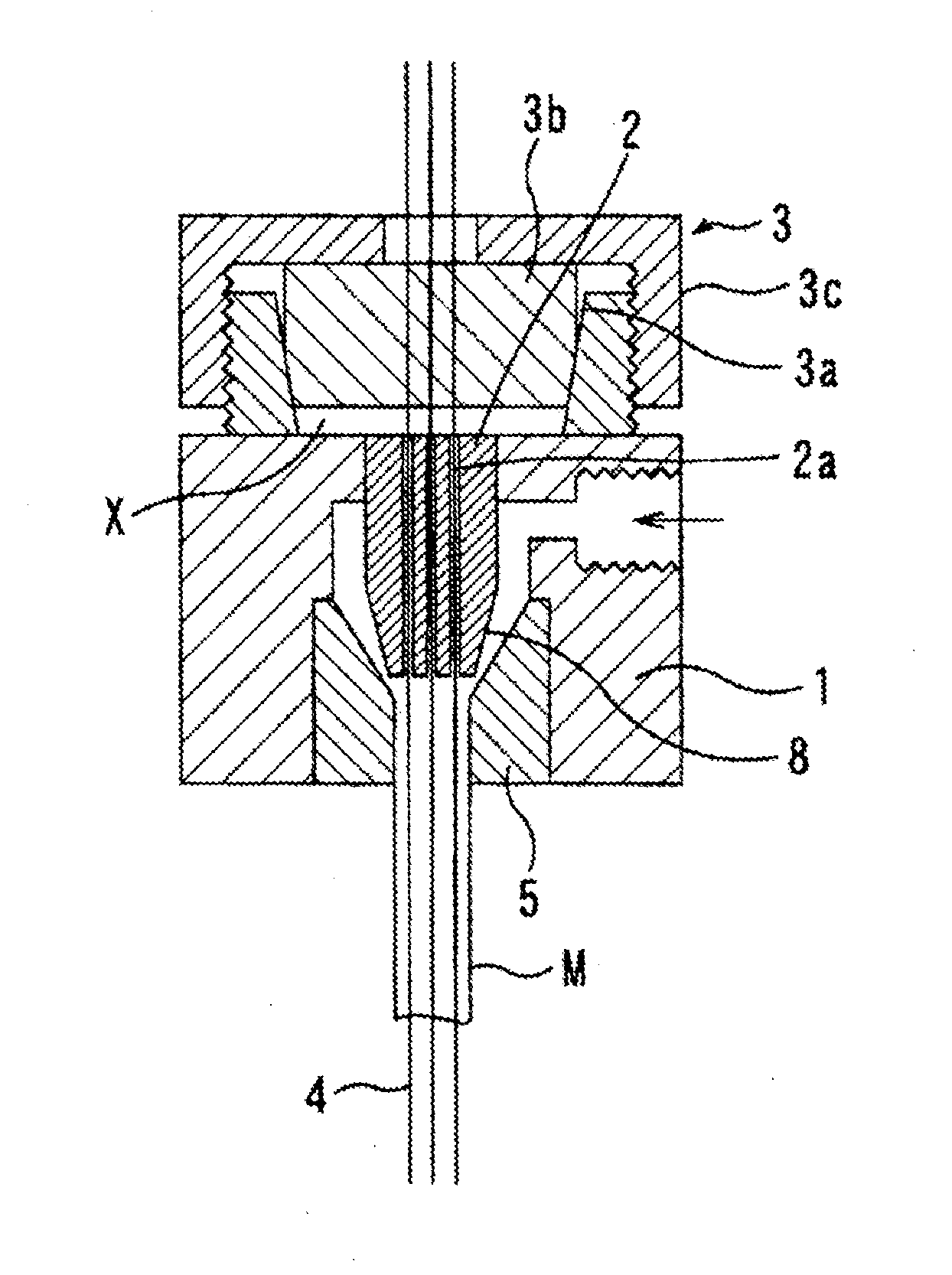Nozzle member and process for producing the same
a technology of nozzles and parts, applied in the field of nozzle parts, can solve the problems of wasting material costs and huge resources on spinning nozzles, affecting the quality of nozzle parts, and damage to through hole forming pins by being bent or broken, etc., to achieve excellent performance, high precision and uniform formation, and the effect of reducing manufacturing costs
- Summary
- Abstract
- Description
- Claims
- Application Information
AI Technical Summary
Benefits of technology
Problems solved by technology
Method used
Image
Examples
example 1
[0040]First, a mixture is prepared by mixing 6 parts by mass of a binder for extrusion molding and 100 parts by mass of a raw material of ceramics for forming a nozzle member of a fluid nozzle in a mixer, and gradually adding a predetermined amount of water to the mixer, wherein the ceramics are alumina-based ceramics in which 0.4 mass % and 0.1 mass % of Al2O3 having 99.9% purity or above and an average particle size of 0.6 μm are respectively substituted by MgO and Y2O3, which are highly pure and fine powder particles.
[0041]Meanwhile, seven guide holes 2a formed in a filament guide 2 installed at the center axis of a nozzle body 1 of a mold for extrusion molding illustrated in FIG. 1 are formed to have a dimensional tolerance within ±1 μm. A filament 4 formed of synthetic resin and having a diameter of 70 μm is drawn from a filament supplier 3 having a back-tension function. The filament 4 is inserted into and passed through each of the guide holes 2a. The filament 4 passes throug...
example 2
[0049]Mullite-based ceramic powder is prepared as a raw material of ceramics for forming the nozzle member, by performing a co-precipitation method on a mixed solution of an aluminum chloride solution and an ethyl silicate solution, in which Al2O3 is from 65 to 75 mass % and SiO2 is from 25 to 35 mass %.
[0050]Alternatively, a compound of Al2O3 and Y2O3 is prepared as the raw material of ceramics, by mixing 99 mass % of Al2O3 powder having 99.5% purity and an average particle size of 0.8 μm and 1 mass % of Y2O3 powder having 99.9% purity and an average particle size of 0.6 μm and 0.3 μm.
[0051]Alternatively, mixed powder is prepared as the raw material of ceramics, by substituting 5 mass % and 3 mass % of Al2O3 powder having 99.5% purity and an average particle size of 0.4 μm by ZrO2 powder partially stabilized with 2.5 mol % of Y2O3.
[0052]Alternatively, ZrO2-based ceramic powder is prepared as the raw material of ceramics, by preparing ZrO2 powder partially stabilized with 2.5 mol % ...
example 3
[0054]A slurry is prepared by pulverizing and mixing 100 parts by mass of Al2O3 powder having 99.99% purity or above and an average particle size of 0.5 μm, 100 L of water, 4 parts by mass of an emulsion type wax-based binder in solid content, 0.5 parts by mass of antifoaming agent, and 0.5 parts by mass of deflocculant by using is a ball mill.
[0055]In order to manufacture a nozzle member from the slurry via cast molding, a mold 9 for cast molding, formed of a porous resin as illustrated in FIG. 5 is used. According to the mold 9, a filament 11 formed of synthetic resin, carbon, a metal, or the like and having a diameter of 100 μm is inserted into and passed through each of seven narrow holes formed in a lower plate member 10 of the mold 9 without a gap, the filament 11 is disposed in a direction of an center axis of the mold 9, an absorption container 12 that is divided into halves is attached around a protruding portion 10a of the lower plate member 10, as a porous resin mold, wit...
PUM
| Property | Measurement | Unit |
|---|---|---|
| Length | aaaaa | aaaaa |
| Length | aaaaa | aaaaa |
| Fraction | aaaaa | aaaaa |
Abstract
Description
Claims
Application Information
 Login to View More
Login to View More - R&D
- Intellectual Property
- Life Sciences
- Materials
- Tech Scout
- Unparalleled Data Quality
- Higher Quality Content
- 60% Fewer Hallucinations
Browse by: Latest US Patents, China's latest patents, Technical Efficacy Thesaurus, Application Domain, Technology Topic, Popular Technical Reports.
© 2025 PatSnap. All rights reserved.Legal|Privacy policy|Modern Slavery Act Transparency Statement|Sitemap|About US| Contact US: help@patsnap.com



